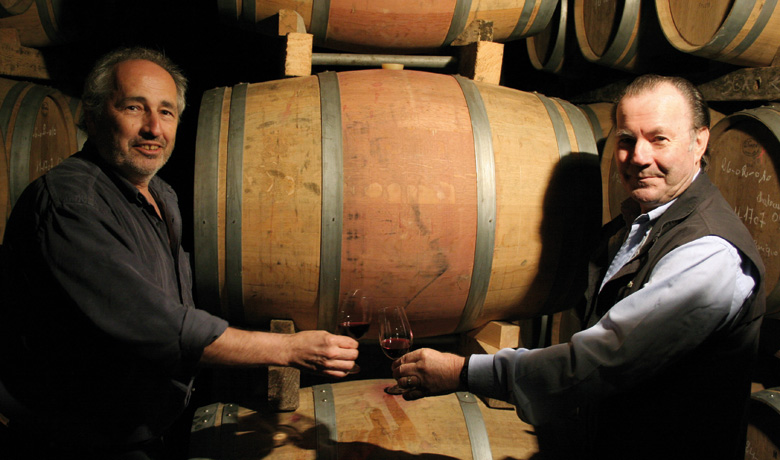Winegrowers’ Châteauneuf-du-Pape

The 52 hectares in one piece are spread over the hillside then the plateau, and represent the viticultural heritage of Château de la Gardine. Here we are in the heart of the appellation Châteauneuf-du-Pape and the horizon stretches to the South. The estate is born in 1943 from Gaston Brunel's willing to buy the farmhouse to which he will add a tower to underline the idea of castle. The vine will come later on, 8 hectares to start with. Exactly like this bottle with this so particular shape. “My grand-father discovered this very original model during the works undertaken in the cellar, Marie-Odile Brunel explains. She is the daughter of Maxime, one of the two heirs, in charge of the vinification but also of the export sales. He immediately looked for a firm able to copy it and he found one in Italy. Since 1952 this choice is a reference, an image and an investment. It has to be said that this bottle costs 45 eurocents more than a classical bottle.”
 Fineness and elegance
Fineness and eleganceBut before this original bottle appears on the tables of the greatest French restaurants, from the Maison Pic to Paul Bocuse's, from the Meurice to the Plaza Athénée, everything is at stake in the vineyard. And there Gaston Brunel's heirs do not lack assets.
“Of course, Marie-Odile goes on, we count on the 13 varietals of the appellation, but we are lucky enough to have our vineyard on the three types of soils which give all the character and quality to the wines of Châteauneuf-du-Pape. That is to say rolled pebbles on the North plateau, limestone in the West and at last a mix of earth and pebbles at the foot of the château, in a sector where rainfalls are rare as the Rhône River provides a kind of shield. Naturally while regulation limits the production at 35 hl/ha, we always are under an average of 28.”
Château de la Gardine's vineyard is also rich of another particularity, the average age of its vines which is 45 years old. “This whole enables us to offer wines which are greedy, fruity, fine and elegant. It is sometimes said they lack tannins but in fact they are very discreet and release through the time. It is the ageing which ensures them to reveal. It has to be said also that we blend in the cellar before vinification…”
A qualitative choice confirmed by Hervé Schmitt, Chef Sommelier of the new starred Alsacian restaurant Le Relais de la Poste in La Wantzenau. “The red Châteauneuf-du-Pape is marked by a greedy character.
It displays a lovely refinement… but I have a special feeling for the cuvée Marie-Léoncie, a white wine of which I appreciate the appropriateness of the maturation and accuracy of the vinification.”


To reach these results, a precise knowledge of the character of the plots and their production is required. This is Marie-Odile Brunel's business: “As from the beginning of September, we regularly taste the berries. This enables us to optimize the phenolic maturity because for us the sugar is not all! We always start with the Grenache and the Syrah and at mid-campaign we add the Mourvèdre. Some plots are picked in several times and there is sometimes a 10 to 12-day interval between the beginning and the end.”
The harvest is then totally done manually which denotes a great respect for the grape. On a more global point of view, Château de la Gardine also adopted a responsible approach by limiting—or even stopping—the treatment of the soils. The observation of the nature during spring 2011, with early heat, lets foresee a vintage very similar to 2009. “2009 will exactly be a vintage to be laid down; it can be consumed quickly if the tannins do not disturb and if the dishes are well-chosen. But at the moment it is the 2008 which arrives on the market, a year with a reduced volume.”
To harvest as well as to consume, at Château de la Gardine, they show a real patience.

Fax : +33(0)4 90 83 77 24